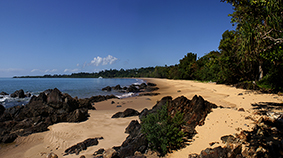Media release by Alliance to Save Hinchinbrook (ASH).

Click to enlarge
The Cassowary Coast Shire Council has just thrown the Port Hinchinbrook maintenance mess onto the Queensland government. But they may not realise that it will come bouncing right back.
Under pressure from the canal estate residents, the Council has persuaded the State government to enforce the Deed of Agreement, which states that the developer will keep the waterways open. The State says it will spend taxpayer's money to carry out dredging and recover the costs from the developer.
But after some bond moneys lodged by the developer are absorbed, there is no way of forcing payment for continuing high dredging costs. The easy "out" for the developer is to wind up the company.
Under pressure from the canal estate residents, the Council has persuaded the State government to enforce the Deed of Agreement, which states that the developer will keep the waterways open. The State says it will spend taxpayer's money to carry out dredging and recover the costs from the developer.
But after some bond moneys lodged by the developer are absorbed, there is no way of forcing payment for continuing high dredging costs. The easy "out" for the developer is to wind up the company.
In 2007, local real estate agent Lindsay Hallam and contractor John Wood went to the Cassowary Coast Regional Council to get the Council to take over the dredging of the Port Hinchinbrook Grande Canal, promising no dredging required for six years.
Fortunately for the shire's ratepayers, the 1997 Council refused, not wanting to burden ratepayers with Keith Williams' estimate of "$600 thousand dollars a year to dredge the channel" (Hinchinbrook decision paves the way for rock wall development, ABC farnorth/stories, Thursday, 19 October 2006).
Within a year of the dredging, the canals and marina were again well-silted. The breakwalls did not solve the siltation problem.
In going to the State this year for enforcement of the infamous Deed of Agreement, the Council has now initiated a process which will most likely result in the Council being lumbered with all the Port Hinchinbrook maintenance. If the state presses its case, the developer is most likely to wind up the company, leaving the state government (and taxpayers) the poorer. After that, the Council will be left to pick up the tab - an ongoing cost on all Cassowary Coast ratepayers.
The new dredging licence (2010) for "Port Hinchinbrook" makes the dredge operator responsible for preventing any salt water intrusion into the ground water, including daily monitoring of numerous bores all around the new temporary spoil pond, for the life of the storage. The pond must emptied before it can be re-used; and no-one wants the acid and salt spoil. The chances of finding an operator prepared to take on this job are remote indeed.
From the outset (1993), state and local governments repeatedly ignored the known facts and conservationists’ warnings. The 1977 Harbours and Marine Department studies plainly stated that the Oyster Point site was not suitable as a boat harbour because it lacked natural deep water, was flood prone and subject to severe siltation. Why go on throwing good money after bad?
Ms Moorhouse said "We get no joy out of saying we told you so - it's time to get real now, let go the pie-in-the-sky promise of all-tides access, and learn to use the tides. It's not rocket science".
Alliance to Save Hinchinbrook Inc.
CONTACT: Margaret Moorhouse (Mob) 0427 724 052
email: [email protected]
Fortunately for the shire's ratepayers, the 1997 Council refused, not wanting to burden ratepayers with Keith Williams' estimate of "$600 thousand dollars a year to dredge the channel" (Hinchinbrook decision paves the way for rock wall development, ABC farnorth/stories, Thursday, 19 October 2006).
Within a year of the dredging, the canals and marina were again well-silted. The breakwalls did not solve the siltation problem.
In going to the State this year for enforcement of the infamous Deed of Agreement, the Council has now initiated a process which will most likely result in the Council being lumbered with all the Port Hinchinbrook maintenance. If the state presses its case, the developer is most likely to wind up the company, leaving the state government (and taxpayers) the poorer. After that, the Council will be left to pick up the tab - an ongoing cost on all Cassowary Coast ratepayers.
The new dredging licence (2010) for "Port Hinchinbrook" makes the dredge operator responsible for preventing any salt water intrusion into the ground water, including daily monitoring of numerous bores all around the new temporary spoil pond, for the life of the storage. The pond must emptied before it can be re-used; and no-one wants the acid and salt spoil. The chances of finding an operator prepared to take on this job are remote indeed.
From the outset (1993), state and local governments repeatedly ignored the known facts and conservationists’ warnings. The 1977 Harbours and Marine Department studies plainly stated that the Oyster Point site was not suitable as a boat harbour because it lacked natural deep water, was flood prone and subject to severe siltation. Why go on throwing good money after bad?
Ms Moorhouse said "We get no joy out of saying we told you so - it's time to get real now, let go the pie-in-the-sky promise of all-tides access, and learn to use the tides. It's not rocket science".
Alliance to Save Hinchinbrook Inc.
CONTACT: Margaret Moorhouse (Mob) 0427 724 052
email: [email protected]





 RSS Feed
RSS Feed